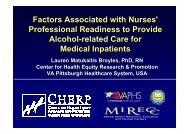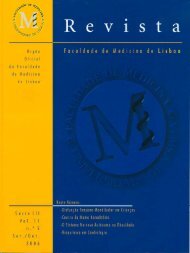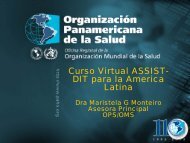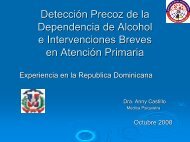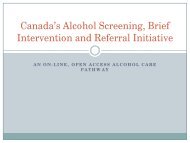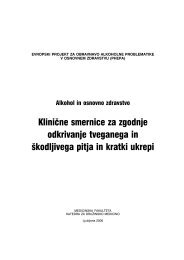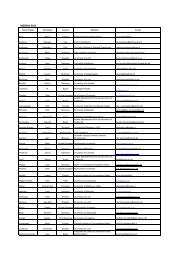Beatriz Roson - INEBRIA
Beatriz Roson - INEBRIA
Beatriz Roson - INEBRIA
You also want an ePaper? Increase the reach of your titles
YUMPU automatically turns print PDFs into web optimized ePapers that Google loves.
Detection and quality of<br />
alcohol consumption<br />
history-taking taking in a Tertiary<br />
University Hospital in<br />
Catalonia, Spain.<br />
<strong>Beatriz</strong> Rosón, M. Pino Alonso, Ana Belén<br />
Martinez, Ferran Bolao, Julio Vallejo,<br />
Ramón Pujol.<br />
Internal Medicine, Psychiatry Services.<br />
Hospital Universitario de Bellvitge.<br />
L’Hospitalet de Llobregat
Nurses often<br />
underestimate alcohol<br />
consumption in<br />
hospitalised patients with<br />
unhealthy alcohol use<br />
Ana Belén Martinez, <strong>Beatriz</strong> Rosón, Iván<br />
Pelegrí, M. Pino Alonso, Mar Lázaro.<br />
Internal Medicine, Psychiatry Services.<br />
Hospital Universitario de Bellvitge.<br />
L’Hospitalet de Llobregat
Background<br />
• Quantification of alcohol intake is the<br />
initial step to assess adequately the<br />
alcohol drinking pattern<br />
• There are scarce data in medical<br />
literature regarding adequacy of alcohol<br />
consumption history-taking in different<br />
clinical settings, and particularly<br />
regarding routine hospital practice.
Background<br />
• Rates of recording quantitative alcohol<br />
consumption vary widely in different studies<br />
– Primary care<br />
• Babor TE, 2005<br />
» 24- 50% nurses records<br />
» 19- 44% medical records<br />
• Bueno Ortiz JM, 1997<br />
» 24% medical records<br />
– General Internal Medicine Ward<br />
• Lloyd G, 1982<br />
» 94% medical records<br />
» underestimation of the amount consumed and<br />
dependence symptoms
Objectives<br />
1) To assess the methods of<br />
registering alcohol consumption in<br />
our institution<br />
→ medical records<br />
→ nurses histories<br />
2) To identify factors associated<br />
with recording
Patients and Methods<br />
• Design: prospective, observational<br />
• Setting: 800-bed University hospital that<br />
serves and area of 1 million inhabitants in<br />
Southern Barcelona<br />
• Populations studied:<br />
1) General hospitalized population: All adult<br />
patients hospitalized for any reason on December<br />
15,2005. (cross-sectional)<br />
2) Patients with unhealthy alcohol use: All patients<br />
who had been prospectively identified by the<br />
brief intervention team between October 2002<br />
and October 2005. (longitudinal)
Patients and Methods<br />
• Information about alcohol use was collected<br />
from the medical and nurses’ histories for<br />
the current admission.<br />
• Alcohol use and drinking patterns<br />
– AUDIT-C, AUDIT-10, MALT questionnaires<br />
and clinical assessments.<br />
– Consumption was considered to be<br />
underestimated when patients were not<br />
assessed or were classified as not drinkers<br />
or “light drinkers” in nurses’ records.
General hospitalized population<br />
Patients in conventional<br />
medical and surgical wards<br />
597<br />
Excluded<br />
124<br />
45% dementia/communication problems<br />
24% discharged before interview<br />
Interviewed patients<br />
473<br />
Reviewed medical<br />
and nurses' records<br />
455 (96%)
Patients’ characteristics<br />
Characteristics<br />
n<br />
Gender, men 259 (57%)<br />
Age yr, x ± SD 63.5 ± 16.7<br />
Source of admission<br />
Emergency 301 (66%)<br />
Scheduled 136 (30%)<br />
Unknown 18 (4%)<br />
Type of ward<br />
Medical 183 (40%)<br />
Surgical 272 (60%)
Patients’ characteristics<br />
Characteristics x ± SD range<br />
AUDIT-C scores 2.0 ± 3.2 0-12<br />
AUDIT-10 scores 2.2 ± 3.8 0-33<br />
Daily Standard drinks<br />
consumption<br />
1.2 ± 2.5 0-20<br />
Weekly Standard drinks<br />
consumption<br />
7.3 ± 17.8 0-140
Drinking patterns in 455<br />
hospitalized patients<br />
Low-risk<br />
36%<br />
At-risk<br />
drinking<br />
8%<br />
Abuse<br />
1%<br />
Abstainers<br />
51%<br />
Dependence<br />
4%
Methods of alcohol<br />
consumption evaluation in<br />
medical records in general<br />
inpatient population<br />
qualitative<br />
5%<br />
Not recorded<br />
58%<br />
191<br />
Recorded<br />
42%<br />
Not drinker<br />
69%<br />
129<br />
Grams=2<br />
SD=4<br />
10<br />
quantitative<br />
3%<br />
41<br />
semi-quantitative<br />
22%<br />
6 Light =20<br />
moderate=13<br />
heavy=8
Factors associated with lack of<br />
register in medical histories<br />
Audit-C<br />
1,9<br />
2,1<br />
Mean Age,<br />
yr<br />
65<br />
64,2<br />
surgical<br />
ward<br />
39<br />
73<br />
*<br />
Registered<br />
Not registered<br />
scheduled<br />
admission<br />
20<br />
39<br />
*<br />
Female<br />
34<br />
48<br />
*<br />
*P
Register according to<br />
drinking pattern<br />
dependence<br />
2<br />
5<br />
Not recorded<br />
Recorded<br />
abuse<br />
1<br />
2<br />
at-risk<br />
Abstainers<br />
8<br />
7<br />
84<br />
P =NS<br />
89<br />
0 10 20 30 40 50 60 70 80 90 100
Type of Register according<br />
to drinking pattern<br />
100<br />
90<br />
Not drinkers Qualitative Semi-quantitative Quantitative<br />
80<br />
70<br />
% cases<br />
60<br />
50<br />
40<br />
30<br />
20<br />
10<br />
0<br />
Abstainers<br />
at-risk<br />
abuse<br />
dependence
Alcohol use register in medical<br />
histories according to speciality<br />
ward<br />
100<br />
90<br />
94%<br />
80<br />
70<br />
60<br />
50<br />
40<br />
42%<br />
30<br />
20<br />
10<br />
0<br />
0%
Recording of alcohol<br />
use in nurses’ ’ records
Type of register according<br />
to drinking pattern in<br />
nurses’ ’ records<br />
100<br />
% cases<br />
90<br />
80<br />
70<br />
60<br />
50<br />
40<br />
30<br />
20<br />
10<br />
0<br />
Not recorded Alcohol no Alcohol yes<br />
68% cases registered<br />
Abstainers<br />
at-risk<br />
abuse<br />
dependence
Alcohol use register in nurses’<br />
histories according to<br />
100<br />
90<br />
80<br />
70<br />
60<br />
50<br />
40<br />
30<br />
20<br />
10<br />
0<br />
speciality ward<br />
14%<br />
100%<br />
68%
Screening<br />
Drinking pattern<br />
Organic complications<br />
Simple advice<br />
Drinking pattern<br />
Motivational interview
Population with unhealthy<br />
alcohol use<br />
Patients in medical wards<br />
assessed by the BIT<br />
3785<br />
Patients with unhealthy<br />
alcohol use<br />
539 (14%)<br />
Reviewed nurses records<br />
522 (97%)
Patients’ characteristics<br />
Characteristics N=522<br />
Gender, men 438 (84%)<br />
Age yr., x ± SD 54.1 ± 15.1<br />
Marital status<br />
Single 81 (15%)<br />
Employment<br />
Married 224 (43%)<br />
Divorced/separated 61 (12%)<br />
Other 43 (8%)<br />
Unknown 112 (21%)<br />
Employed/working 132 (25%)<br />
Unemployed 48 (9%)<br />
Retired 178 (34%)<br />
Other 53 (10%)<br />
Unknown 110 (21%)
Patients’ characteristics<br />
Characteristics N=522<br />
Source of admission<br />
Emergency 470 (90%)<br />
Scheduled 21 (4%)<br />
Other 30 (6%)<br />
Type of ward<br />
Internal Medicine 277 (53%)<br />
Psychiatry 61 (12%)<br />
Gastroenterology 177 (34%)<br />
Previous diagnosis of<br />
231 (44%)<br />
dependence/abuse<br />
AUDIT-C, mean (range) 9.3 (4-12)<br />
AUDIT-10, mean (range) 15.3 (6-36)<br />
MALT, mean (range) 11.1 (0-44)<br />
Standard drinks per day, mean<br />
(range)<br />
10 (0-90)
Drinking patterns in 522<br />
patients with unhealthy<br />
alcohol use<br />
295<br />
Dependence<br />
56%<br />
At-risk<br />
Abuse<br />
10%<br />
50<br />
drinking<br />
34%<br />
177
Recording of alcohol<br />
use in nurses’ ’ records<br />
Side notes
Methods of evaluation of alcohol<br />
consumption in nurses’ ’ records in<br />
522 patients with unhealthy<br />
alcohol use<br />
Not registered<br />
28%<br />
qualitative<br />
24%<br />
145<br />
Registered<br />
72%<br />
377<br />
Not drinker<br />
34%<br />
127<br />
23<br />
92<br />
135<br />
semiquantitative<br />
36%<br />
Grams=20<br />
SD=3<br />
quantitative<br />
6%<br />
Light =9<br />
moderate=28<br />
heavy=98
Type of register according to drinking<br />
pattern in nurses’ ’ records of 522<br />
patients with unhealthy alcohol use<br />
100<br />
90<br />
Not drinkers Qualitative Semiquantitative Quantitative<br />
80<br />
70<br />
% cases<br />
60<br />
50<br />
40<br />
30<br />
20<br />
10<br />
0<br />
at-risk<br />
abuse<br />
dependence
Factors associated with<br />
understimation of alcohol consumption<br />
in nurses’ ’ records<br />
100<br />
80<br />
60<br />
40<br />
20<br />
0<br />
Underestimated<br />
66 % 75 % 51 % 54 %<br />
Not underestimated<br />
36 %<br />
At risk drinkers<br />
Dependence<br />
Abusers<br />
Overall<br />
Assessed<br />
• Women gender 15% vs 9%<br />
• Standard drinks per day 10 vs 12<br />
* patients without register were included in the analyses as underestimated
Methods of evaluation of alcohol<br />
consumption in medical records in<br />
539 patients with unhealthy<br />
alcohol use<br />
Not registered<br />
37%<br />
199<br />
Registered<br />
63%<br />
340<br />
qualitative<br />
22%<br />
127<br />
Not drinker<br />
12%<br />
quantitative<br />
7%<br />
semi-quantitative<br />
56%
Conclusions<br />
Regarding medical records in general hospital<br />
population<br />
• Adequate quantitative alcohol history<br />
taking was rarely performed.<br />
• The need of increasing alcohol use<br />
records should be stressed,<br />
particularly in females, surgical wards<br />
and scheduled admissions.
Conclusions<br />
Regarding nurses histories in population with<br />
unhealthy alcohol use<br />
• Nurses register alcohol consumption in<br />
most inpatients, however quantification<br />
is rarely performed.<br />
• Alcohol use is often underestimated by<br />
nurses, particularly in women and atrisk<br />
drinkers and abusers
Conclusions<br />
For the BIT<br />
• Urgent need to standardise and<br />
improve methods of alcohol<br />
consumption register in our hospital<br />
• Differences between nurse and<br />
medical staff should be assessed<br />
• Need to control the evolution of the<br />
quality of the nurses and medical<br />
records regarding alcohol use



